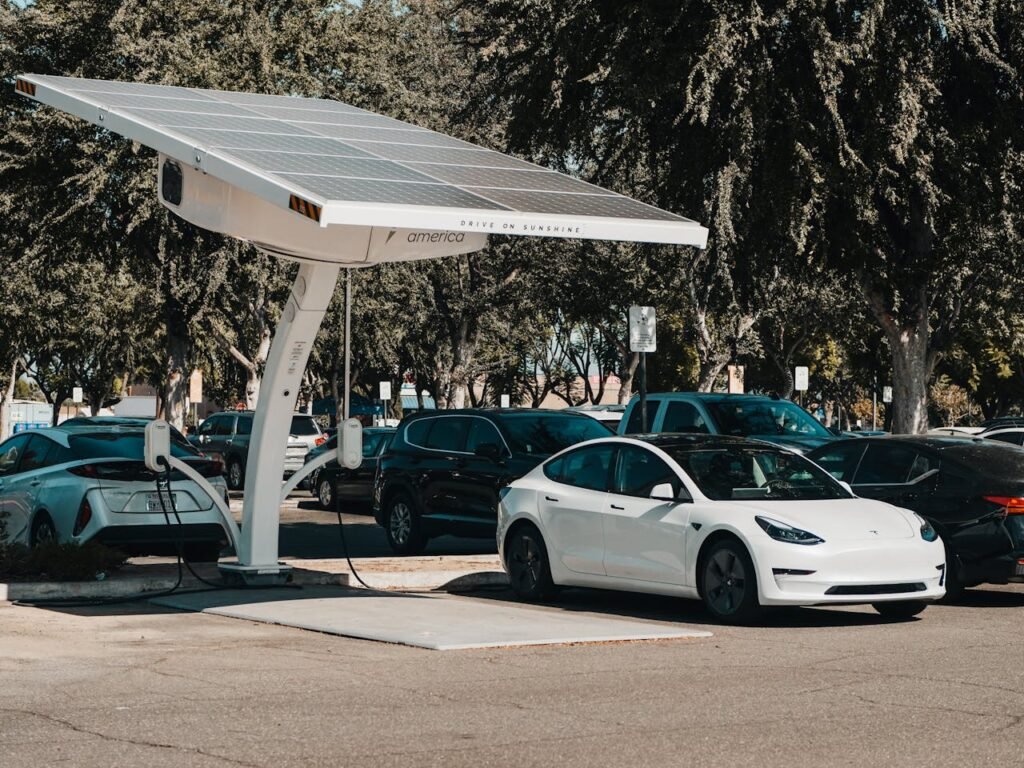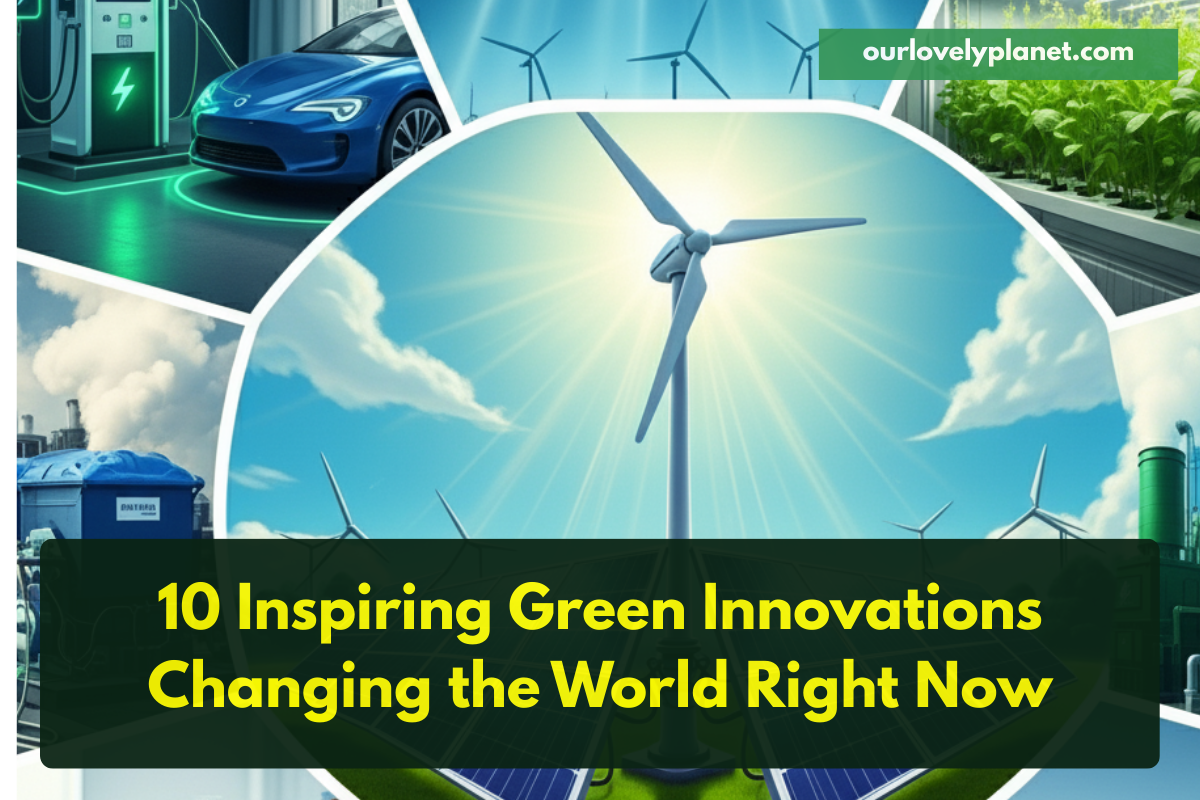This isn’t about someday. It’s about today. In 2024 the world added 585 gigawatts (GW) of renewable power. That was the largest one-year jump ever, pushing global renewables to 4,448 GW and about 46% of total installed power capacity.
Solar and wind made up 96.6% of net renewable additions. China alone put 278 GW of solar on the grid last year. Momentum is real, even if we still need to go faster to hit the 2030 tripling goal agreed at COP28.
Electric mobility is in the same gear. In 2024 the world bought over 17 million new electric cars. More than 10 million of those were in China. In 2025, more than one in four cars sold worldwide is expected to be electric. That shift is already displacing around 1.8 million barrels of oil per day, up from 1.3 mb/d in 2023. This is not niche anymore. It is mainstream.
Now, let’s look at 10 innovations already reshaping our lives, markets, and the carbon curve.
1) Solar and Wind at Record Scale
Clean power is the backbone of climate progress. 2024 was a milestone year with 585 GW of renewable capacity added, a growth rate of 15.1%. The total global renewable capacity reached 4,448 GW, and renewables now account for almost half of installed power capacity worldwide. Solar dominated, while wind rebounded with 11% growth after overcoming supply chain bottlenecks.
The regional story matters. China alone added more solar capacity in 2024 than the rest of the world combined. Europe and the U.S. also set records, with the Inflation Reduction Act spurring American projects and the EU racing to hit 2030 renewable targets. But the contrast is stark: Africa added just 4.2 GW in 2024, less than 1% of global growth. That gap highlights the need for fair financing to spread clean power everywhere.

The challenge is urgency. To hit the global tripling goal by 2030, annual growth must climb to 16.6%. That means clearing permitting hurdles, investing in new transmission lines, and making grids smarter. Solar panels and wind turbines are proven. The next frontier is building systems that connect and balance them at scale.
2) Big Batteries Quietly Rewiring the Grid
Energy storage is the glue holding the clean grid together. Without storage, solar and wind risk being curtailed when supply exceeds demand. Batteries fix that by soaking up excess power, releasing it at night, and stabilizing frequency in real time.
In 2024, the United States installed a record 15.2 GW of new battery storage, nearly doubling the 2023 figure. Another 25 GW is expected in 2025 if projects connect on schedule. Globally, storage deployments passed 45 GW and nearly 100 GWh in 2024 for the first time. That is enough to make renewables truly reliable.
This isn’t just about lithium-ion. Startups are scaling long-duration storage technologies, like iron-air batteries and molten salt, that can deliver clean power for days. Virtual power plants, which link thousands of home batteries together, are also taking off. In California, Tesla’s virtual power plant already stabilizes the grid during peak demand.
The bottom line: batteries are becoming as important as power plants. Every gigawatt installed makes renewables more flexible, grids more resilient, and fossil peaker plants less relevant.
3) Electric Vehicles Becoming Mainstream
The S-curve is here. In 2024 the world bought over 17 million Electric vehicles (EVs). China alone accounted for more than 10 million. In 2025, EVs will make up more than 25% of global car sales. This demand is displacing about 1.8 million barrels of oil per day, compared with 1.3 mb/d in 2023.

Prices keep falling. Battery pack costs dropped another 14% in 2024 to $115/kWh, the lowest ever. Cheaper batteries mean cheaper cars and faster adoption.
4) Heat Pumps: The Silent Efficiency Revolution
Three units of heat for one unit of electricity. That simple math explains why heat pumps are transforming heating. The global picture is mixed. The IEA says global sales fell about 1% in 2024 after a slow start, and in Europe sales dropped around 21–23% year-on-year to about 2.2 million units. Policy shifts and lower gas prices hurt growth. But adoption is still measured in millions per year, and countries like the UK saw gains.
The long-term story remains strong. Heat pumps remain one of the most cost-effective ways to cut emissions in buildings and industry, especially as electricity grids keep cleaning up.
5) Green Hydrogen: Electrolyzers Scaling Fast
Electrolyzers are moving from pilot to production. Installed water-electrolyzer capacity hit about 1.4 GW by the end of 2023, almost doubling from the year before. Manufacturing capacity reached 25 GW per year. The pipeline of announced projects is now around 520 GW by 2030. In 2024, projects reaching final investment decision doubled compared with 2023.
Hydrogen made with renewables can decarbonize steel, fertilizers, refineries, and shipping fuels. Right now less than 1% of hydrogen is low-emission, but the buildout curve is steep.
6) Direct Air Capture Moving Into Reality
Carbon removal is no longer theoretical. In May 2024, Climeworks switched on Mammoth in Iceland. It is the largest direct-air-capture (DAC) plant in the world, with a capacity of 36,000 tons of CO₂ per year when fully operational. The plant runs on geothermal energy and stores carbon permanently underground. It is about ten times larger than the company’s earlier Orca project.
Volumes are still tiny compared with global emissions, but the learning curve begins with real plants like this one. The priority is scaling with clean energy, reliable monitoring, and permanent storage.
7) Sustainable Aviation Fuel Gaining Altitude
Aviation needs liquid fuels, not wires. In 2024, global production of sustainable aviation fuel (SAF) doubled to about 1 million tonnes, or 1.3 billion liters. That is only 0.3% of jet fuel demand, but it is progress. In 2025 output is expected to reach 2.1 million tonnes as more capacity comes online in the United States and Europe.

The leap required is massive. The sector will need order-of-magnitude growth, along with stable policy and cheaper feedstocks, to truly decarbonize.
8) Cleaning Oceans at Scale
We are finally pulling plastics out of water, not just talking about it. In 2024, The Ocean Cleanup removed 11.5 million kilograms of trash from rivers and the Great Pacific Garbage Patch. On October 18, 2024, their system collected 120,832 kilograms in a single day, a new record.
It is a reminder that technology and persistence can tackle entrenched pollution. We still need upstream bans and better design, but industrial-scale cleanup is now proving itself.
9) Battery Prices Keep Falling
Falling costs open new markets. BloombergNEF reported that lithium-ion pack prices dropped to $115/kWh in 2024. That was a 14% decline from 2023 and an 84% fall from 2010. Lower costs make EVs cheaper, grid storage more viable, and industrial electrification more competitive.
Every $10/kWh decline brings new sectors into reach, from ferries to forklifts. That is how technology pushes adoption forward.
10) A Cleaner Grid, But Uneven Progress
The world is installing clean power at record speed. By the end of 2024, renewables made up about 46% of installed power capacity worldwide. But the growth is uneven. China, the U.S., and the EU accounted for about 84% of new additions. Africa added just 4.2 GW, less than 1% of the total.
That gap matters. Distributed solar, mini-grids, and smarter utilities could allow developing regions to leapfrog fossil fuels if financing lines up.
What You Can Do Right Now
Big shifts start with small choices. These ten innovations are changing the world, but they scale faster when people like us push for them.
- Choose clean power if your utility or city offers it.
- Pick electric the next time you replace a car, bike, or home appliance.
- Support policy that speeds up renewable energy, storage, and clean transport.
- Vote with your wallet by supporting brands that commit to real sustainability.
- Stay curious and share stories of progress. Hope spreads when we talk about solutions.
The future is already arriving. The question is: will we back it, or will we slow it down?
The Bottom Line
This decade is already rewriting the energy story. In 2024 we saw record renewable additions, more than 17 million EV sales, battery prices at an all-time low, the largest DAC plant ever, and a doubling of sustainable aviation fuel output.
Some sectors slowed, like heat pumps in Europe, but the big picture is clear. Clean technology is no longer a question of if. It is a question of how fast.
If you make, move, heat, cool, or fly anything, your playbook is changing. The solutions are already here. The only mistake now is moving too slowly.




Hey there! This post couldn’t be written any better! Reading this post reminds me of my previous room mate! He always kept chatting about this. I will forward this post to him. Fairly certain he will have a good read. Many thanks for sharing!
Thank you so much for sharing that! I love hearing that the post reminded you of your old roommate — that’s such a fun connection. I really appreciate you passing it along, and I hope he enjoys reading it as much as you did. Thanks again for taking the time to leave such a kind note, it really makes my day!
j6hzpc